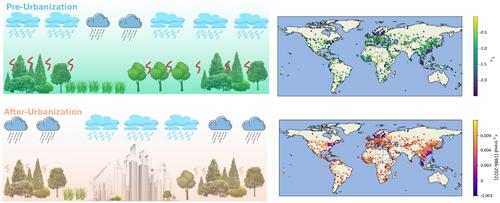当前位置:
X-MOL 学术
›
Glob. Change Biol.
›
论文详情
Our official English website, www.x-mol.net, welcomes your
feedback! (Note: you will need to create a separate account there.)
The Accelerating Loss of Resilience in Suburban Woodlands Can Largely Be Attributed to the Changes in Urban Precipitation Patterns
Global Change Biology ( IF 10.8 ) Pub Date : 2024-10-23 , DOI: 10.1111/gcb.17548 Han Chen, Yuhui Xiang
Global Change Biology ( IF 10.8 ) Pub Date : 2024-10-23 , DOI: 10.1111/gcb.17548 Han Chen, Yuhui Xiang

|
Vegetation resilience holds significant importance for stabilizing ecosystem service functions in a changing climate. While global land surface vegetation resilience changes have been extensively studied, the impact of urbanization on the resilience of suburban woodlands remains inadequately understood. In this study, we utilized two critical slowing down (CSD) indicators, namely lag‐one autocorrelation (LOA) and variance (VA), to assess the vegetation resilience, its long‐term trends, and influencing factors in suburban woodlands across 1356 cities worldwide. The recovery rates estimated by LOA () and VA () showed close alignment in suburban woodlands with low suburban forest coverage (SFC) areas (correlation coefficient (r ) = 0.95). However, a notable divergence was observed in areas with high SFC (r = 0.73). Suburban woodlands with high SFC typically exhibited lower recovery rate estimates, thus indicating greater vegetation resilience compared to areas with lower SFC. From 1986 to 2022, the recovery rates of suburban woodland areas in over 83% of the cities demonstrated a significant upward trend, with an average of 3.23 × 10−3 year−1 for both and , signifying a widespread decline in vegetation resilience. The accelerating pace of urbanization led to higher rising rates of and during 2010–2022 (5.11 × 10−3 year−1 ) compared to 1986–1999 (0.49 × 10−3 year−1 ). The notable decrease in resilience of forestland was primarily attributed to reduced precipitation in urban suburbs, which can be explained by urbanization‐induced heat island and building barrier effects, causing a shift of precipitation center from urban suburbs to central cities. In summary, this study revealed that urbanization diminishes the vegetation resilience of urban suburban woodlands by altering urban precipitation patterns. These findings underscore the necessity of augmenting water availability in urban suburbs to restore resilience in these woodlands, thereby enhancing their ecosystem service value.
中文翻译:

郊区林地恢复力的加速丧失在很大程度上可以归因于城市降水模式的变化
植被恢复力对于在不断变化的气候中稳定生态系统服务功能具有重要意义。虽然全球地表植被恢复力变化已得到广泛研究,但城市化对郊区林地恢复力的影响仍未得到充分了解。在这项研究中,我们利用两个关键的减速 (CSD) 指标,即滞后一自相关 (LOA) 和方差 (VA),来评估全球 1356 个城市郊区林地的植被恢复力、长期趋势和影响因素。通过 LOA () 和 VA () 估计的恢复率显示,在郊区森林覆盖率 (SFC) 区域较低的郊区林地中,恢复率接近一致 (相关系数 (r) = 0.95)。然而,在 SFC 高的区域观察到显着差异 (r = 0.73)。SFC 高的郊区林地通常表现出较低的恢复率估计值,因此表明与 SFC 较低的区域相比,植被恢复能力更强。从 1986 年到 2022 年,超过 83% 的城市郊区林地恢复率呈显著上升趋势,和 和 的平均恢复率为 3.23 × 10-3 年-1,表明植被恢复力普遍下降。城市化步伐的加快导致 2010-2022 年及其期间的增长率(5.11 × 10-3 年-1)与 1986-1999 年(0.49 × 10-3 年-1)相比更高。林地恢复力的显著下降主要归因于城市郊区降水减少,这可以解释为城市化引起的热岛效应和建筑屏障效应,导致降水中心从城市郊区向中心城市转移。 总之,本研究揭示了城市化通过改变城市降水模式来削弱城市郊区林地的植被恢复力。这些发现强调了增加城市郊区水资源供应以恢复这些林地弹性的必要性,从而提高其生态系统服务价值。
更新日期:2024-10-23
中文翻译:

郊区林地恢复力的加速丧失在很大程度上可以归因于城市降水模式的变化
植被恢复力对于在不断变化的气候中稳定生态系统服务功能具有重要意义。虽然全球地表植被恢复力变化已得到广泛研究,但城市化对郊区林地恢复力的影响仍未得到充分了解。在这项研究中,我们利用两个关键的减速 (CSD) 指标,即滞后一自相关 (LOA) 和方差 (VA),来评估全球 1356 个城市郊区林地的植被恢复力、长期趋势和影响因素。通过 LOA () 和 VA () 估计的恢复率显示,在郊区森林覆盖率 (SFC) 区域较低的郊区林地中,恢复率接近一致 (相关系数 (r) = 0.95)。然而,在 SFC 高的区域观察到显着差异 (r = 0.73)。SFC 高的郊区林地通常表现出较低的恢复率估计值,因此表明与 SFC 较低的区域相比,植被恢复能力更强。从 1986 年到 2022 年,超过 83% 的城市郊区林地恢复率呈显著上升趋势,和 和 的平均恢复率为 3.23 × 10-3 年-1,表明植被恢复力普遍下降。城市化步伐的加快导致 2010-2022 年及其期间的增长率(5.11 × 10-3 年-1)与 1986-1999 年(0.49 × 10-3 年-1)相比更高。林地恢复力的显著下降主要归因于城市郊区降水减少,这可以解释为城市化引起的热岛效应和建筑屏障效应,导致降水中心从城市郊区向中心城市转移。 总之,本研究揭示了城市化通过改变城市降水模式来削弱城市郊区林地的植被恢复力。这些发现强调了增加城市郊区水资源供应以恢复这些林地弹性的必要性,从而提高其生态系统服务价值。


















































 京公网安备 11010802027423号
京公网安备 11010802027423号